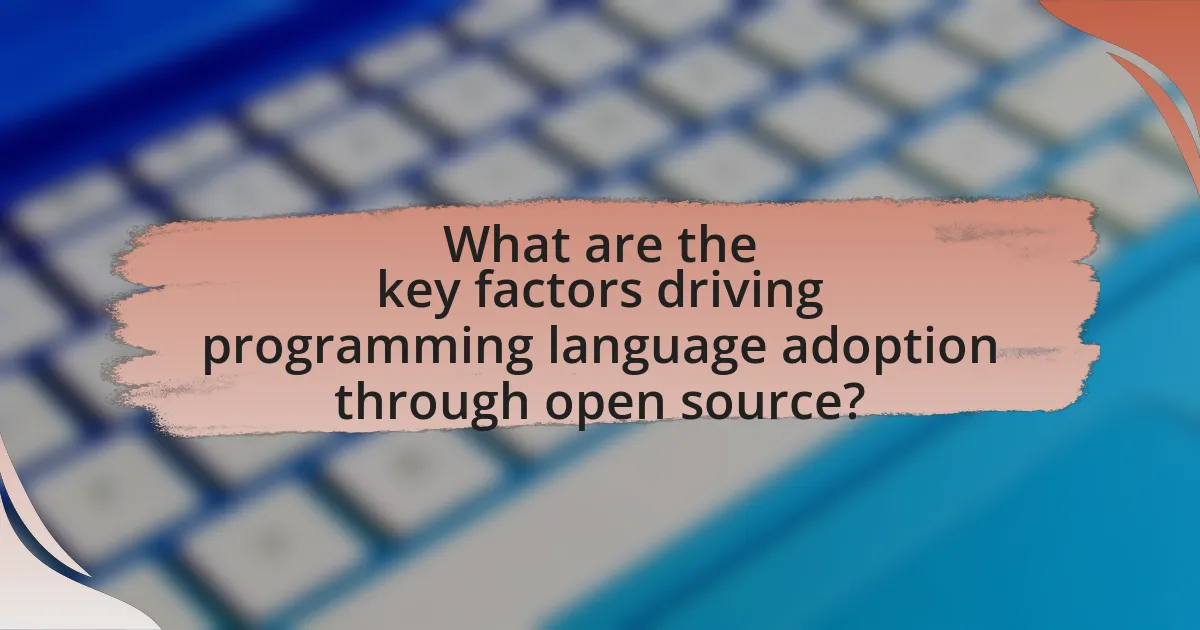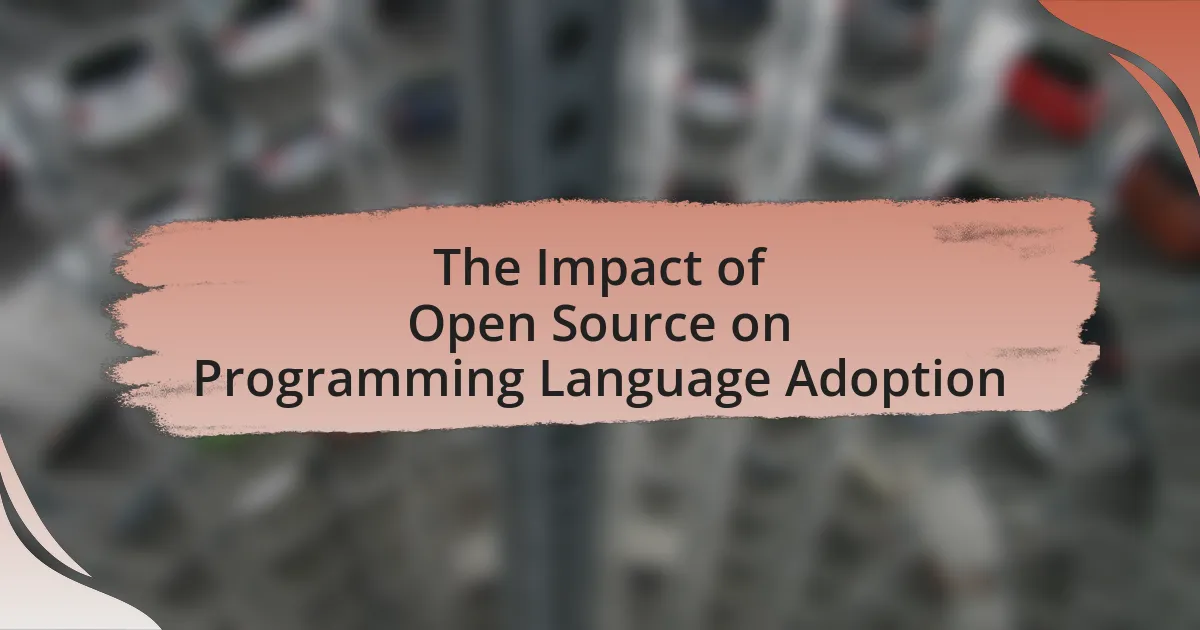The article examines the significant impact of open source on the adoption of programming languages. It highlights how open source resources and community collaboration accelerate the learning and usage of languages like Python and JavaScript, which have gained popularity due to their extensive libraries and frameworks. Key factors driving this trend include community contributions, accessibility, and innovation, while challenges such as documentation quality and integration issues are also discussed. The article emphasizes the importance of community support and practical tips for developers to enhance the adoption of open source programming languages.

What is the Impact of Open Source on Programming Language Adoption?
Open source significantly accelerates programming language adoption by providing accessible resources and fostering community collaboration. The availability of open source projects allows developers to experiment with and learn new languages without financial barriers, leading to increased usage. For instance, languages like Python and JavaScript have seen rapid growth due to extensive open source libraries and frameworks, which enhance their functionality and ease of use. According to the 2021 Stack Overflow Developer Survey, 69.7% of developers reported using open source technologies, highlighting the direct correlation between open source availability and language popularity.
How does open source influence the popularity of programming languages?
Open source significantly enhances the popularity of programming languages by fostering community collaboration and accessibility. When a programming language is open source, it allows developers to contribute to its development, leading to rapid improvements and a diverse ecosystem of libraries and frameworks. For instance, languages like Python and JavaScript have gained immense popularity due to their open source nature, which encourages widespread use and community support. According to the Stack Overflow Developer Survey 2023, Python and JavaScript are among the most loved languages, largely attributed to their open source projects and active communities that provide extensive resources and support. This collaborative environment not only attracts new developers but also retains existing ones, further solidifying the language’s popularity.
What role do community contributions play in language adoption?
Community contributions significantly enhance language adoption by fostering collaboration, improving resources, and increasing visibility. When developers contribute to a programming language’s ecosystem, they create libraries, frameworks, and tools that make the language more accessible and useful. For instance, the rise of Python can be attributed to its extensive community-driven libraries like NumPy and Pandas, which cater to data science and machine learning needs. This collaborative effort not only enriches the language’s functionality but also attracts new users who benefit from these resources, thereby accelerating adoption rates. Furthermore, community contributions often lead to better documentation and support, which are critical factors in a language’s usability and appeal.
How does the availability of open source libraries affect language choice?
The availability of open source libraries significantly influences language choice by providing developers with accessible tools and resources that enhance productivity and reduce development time. When a programming language has a rich ecosystem of open source libraries, it becomes more attractive to developers, as they can leverage existing solutions rather than building functionalities from scratch. For instance, languages like Python and JavaScript have extensive libraries available through platforms like GitHub and npm, which facilitate rapid application development and foster community support. This trend is supported by the 2021 Stack Overflow Developer Survey, which indicated that 69% of developers prefer languages with strong library support, demonstrating a clear correlation between library availability and language adoption.
Why is open source important for new programming languages?
Open source is important for new programming languages because it fosters community collaboration and accelerates innovation. By allowing developers to access, modify, and distribute the source code, open source encourages a diverse range of contributions that can enhance the language’s features and performance. For instance, languages like Python and Ruby gained popularity due to their open source nature, which enabled a vast ecosystem of libraries and frameworks to develop rapidly. This collaborative environment not only improves the language but also builds a supportive community that can drive adoption and provide resources for new users.
What advantages do open source languages have over proprietary ones?
Open source languages offer several advantages over proprietary ones, primarily including cost-effectiveness, flexibility, and community support. Cost-effectiveness arises because open source languages are typically free to use, allowing developers to avoid licensing fees associated with proprietary software. Flexibility is evident as open source languages can be modified and customized to meet specific project needs, unlike proprietary languages that restrict access to source code. Community support is robust, with active contributions from developers worldwide, leading to rapid updates, bug fixes, and a wealth of shared resources. For instance, according to the 2021 Open Source Security and Risk Analysis report by Synopsys, 96% of codebases examined contained open source components, highlighting the widespread adoption and reliance on open source technologies in the industry.
How does open source foster innovation in programming languages?
Open source fosters innovation in programming languages by enabling collaborative development and rapid iteration. This collaborative environment allows developers from diverse backgrounds to contribute ideas, features, and improvements, leading to more robust and versatile programming languages. For instance, the development of Python has significantly benefited from its open-source nature, with contributions from thousands of developers enhancing its libraries and frameworks, which has led to its widespread adoption in various fields such as data science and web development. Additionally, open-source projects often implement cutting-edge technologies and methodologies, allowing programming languages to evolve quickly in response to industry needs and trends.

What are the key factors driving programming language adoption through open source?
The key factors driving programming language adoption through open source include community support, accessibility, and innovation. Community support fosters collaboration and knowledge sharing, which enhances the language’s usability and appeal. For instance, languages like Python and JavaScript have large, active communities that contribute to extensive libraries and frameworks, making them more attractive to developers. Accessibility is another crucial factor; open source languages are often free to use, lowering the barrier to entry for new developers. This is evident in the widespread adoption of languages like Ruby and Go, which are freely available and well-documented. Lastly, innovation within open source projects allows for rapid evolution and improvement of programming languages, as seen with Rust, which has gained popularity due to its focus on safety and performance. These factors collectively contribute to the growing adoption of programming languages in the open source ecosystem.
How does the ease of access to open source languages impact developers?
The ease of access to open source languages significantly enhances developers’ productivity and innovation. Open source languages provide free resources, extensive documentation, and community support, enabling developers to quickly learn and implement new technologies. For instance, the availability of languages like Python and JavaScript has led to a surge in their adoption, with Python’s usage increasing by over 40% in the last five years, according to the TIOBE Index. This accessibility fosters collaboration and knowledge sharing, allowing developers to build upon existing codebases and contribute to projects, which accelerates development cycles and reduces costs.
What resources are available for learning open source programming languages?
Numerous resources are available for learning open source programming languages, including online platforms, documentation, and community forums. Websites like Codecademy, freeCodeCamp, and Coursera offer structured courses on languages such as Python, Ruby, and JavaScript, which are open source. Additionally, official documentation from language maintainers, such as the Python Software Foundation and the Ruby on Rails Guides, provides comprehensive tutorials and references. Community forums like Stack Overflow and GitHub Discussions facilitate peer support and knowledge sharing, enhancing the learning experience. These resources collectively contribute to the accessibility and adoption of open source programming languages.
How do open source communities support new developers?
Open source communities support new developers by providing mentorship, collaborative projects, and access to resources. These communities often have structured programs, such as mentorship initiatives, where experienced developers guide newcomers through the learning process, helping them understand coding standards and best practices. Additionally, collaborative projects allow new developers to contribute to real-world applications, enhancing their skills and confidence. Resources such as documentation, forums, and tutorials are readily available, enabling new developers to learn at their own pace. According to the 2021 Open Source Survey, 70% of respondents indicated that community support was a significant factor in their engagement with open source projects, highlighting the importance of community in fostering new talent.
What trends are emerging in programming language adoption due to open source?
Emerging trends in programming language adoption due to open source include increased popularity of languages like Python, JavaScript, and Go, driven by their extensive libraries and community support. The rise of collaborative development platforms, such as GitHub, has facilitated the sharing and improvement of open-source projects, leading to a surge in the use of these languages. For instance, the TIOBE Index and Stack Overflow Developer Survey consistently show Python’s growth, attributed to its versatility and strong community backing. Additionally, the trend towards microservices architecture has boosted the adoption of languages like Go, which is favored for its performance and simplicity in cloud-native applications.
Which programming languages are gaining traction in the open source community?
Rust and Python are currently gaining significant traction in the open source community. Rust, known for its memory safety and performance, has seen increased adoption due to its use in systems programming and web assembly. According to the Stack Overflow Developer Survey 2023, Rust was voted the most loved programming language for the third consecutive year, indicating strong community support and interest. Python’s popularity continues to rise, particularly in data science and machine learning, with its extensive libraries and frameworks facilitating rapid development. The TIOBE Index for October 2023 shows Python consistently ranking among the top programming languages, reflecting its widespread use and community engagement in open source projects.
How do industry needs shape the evolution of open source languages?
Industry needs significantly shape the evolution of open source languages by driving the demand for specific features, performance enhancements, and community support. For instance, as businesses increasingly adopt cloud computing, open source languages like Python and Go have evolved to include libraries and frameworks that facilitate cloud-native development, reflecting the industry’s shift towards scalable and efficient solutions. Additionally, the rise of data science and machine learning has led to the enhancement of languages such as R and Julia, which now offer robust packages tailored for data analysis and statistical modeling. This evolution is further supported by the active contributions from industry professionals who prioritize practical applications and real-world problem-solving, ensuring that open source languages remain relevant and aligned with current technological trends.

What challenges exist in the adoption of programming languages influenced by open source?
The challenges in the adoption of programming languages influenced by open source include issues related to community support, documentation quality, and compatibility with existing systems. Community support can be inconsistent, as many open-source projects rely on volunteer contributions, leading to varying levels of responsiveness and expertise. For instance, a study by the Open Source Initiative found that 60% of developers reported difficulties in finding adequate support for open-source languages. Additionally, documentation quality often varies significantly, which can hinder new users from effectively learning and utilizing the language. A survey conducted by Stack Overflow indicated that poor documentation is a primary reason developers abandon open-source projects. Lastly, compatibility issues with legacy systems can pose significant barriers, as organizations may be reluctant to adopt new languages that do not integrate well with their existing technology stack. These challenges collectively impact the widespread adoption of open-source influenced programming languages.
What are the common misconceptions about open source programming languages?
Common misconceptions about open source programming languages include the belief that they are inherently less secure than proprietary languages, that they lack professional support, and that they are only suitable for hobbyists or small projects. In reality, many open source languages, such as Python and JavaScript, are widely used in enterprise environments and benefit from extensive community support and contributions. Additionally, studies have shown that open source software can be as secure, if not more so, than proprietary alternatives due to the transparency of the code and the ability for a large number of developers to identify and fix vulnerabilities quickly. For instance, the Open Source Security Foundation reported that open source projects often have faster patching times compared to closed-source software.
How do licensing issues affect language adoption?
Licensing issues significantly affect language adoption by determining the legal framework under which a programming language can be used, modified, and distributed. For instance, languages with permissive licenses, such as the MIT License, encourage adoption by allowing developers to freely use and integrate the language into their projects without stringent restrictions. In contrast, languages with more restrictive licenses, like the GNU General Public License (GPL), may deter adoption due to concerns about compliance and the obligation to disclose source code. Historical examples include the widespread adoption of Python, which is under a permissive license, compared to languages like Java, which has faced challenges due to its licensing model. This demonstrates that the type of license can directly influence a language’s popularity and the willingness of developers to adopt it.
What barriers do organizations face when adopting open source languages?
Organizations face several barriers when adopting open source languages, including concerns about security, lack of support, and integration challenges. Security issues arise from the perception that open source software may be more vulnerable to attacks due to its publicly accessible code. Additionally, organizations often encounter a lack of formal support compared to proprietary software, which can hinder troubleshooting and maintenance. Integration challenges occur when open source languages do not seamlessly fit into existing systems or workflows, complicating the adoption process. These barriers can significantly impact an organization’s decision-making regarding the use of open source languages.
How can developers overcome challenges in adopting open source programming languages?
Developers can overcome challenges in adopting open source programming languages by actively engaging with the community, utilizing comprehensive documentation, and leveraging existing tools and frameworks. Engaging with the community allows developers to seek support, share knowledge, and collaborate on solutions, which is crucial given that 90% of developers report community support as a key factor in their success with open source projects. Comprehensive documentation provides essential guidance and best practices, reducing the learning curve associated with new languages. Additionally, leveraging existing tools and frameworks can streamline development processes, as many open source languages come with robust ecosystems that facilitate integration and deployment.
What best practices should developers follow when choosing an open source language?
Developers should prioritize community support, documentation quality, and project activity when choosing an open source language. A strong community ensures that developers can find help and resources, which is crucial for problem-solving and collaboration. High-quality documentation facilitates learning and implementation, making it easier for developers to adopt the language effectively. Additionally, active project maintenance indicates ongoing support and updates, which are essential for security and feature enhancements. According to a 2021 survey by Stack Overflow, 70% of developers consider community support as a key factor in their language choice, highlighting its importance in the decision-making process.
How can collaboration within open source communities enhance language adoption?
Collaboration within open source communities enhances language adoption by fostering a shared environment for development, innovation, and support. This collaborative approach allows developers to contribute to the language’s ecosystem, creating libraries, frameworks, and tools that increase its usability and appeal. For instance, the rapid growth of Python’s popularity can be attributed to its extensive community contributions, which have led to a rich set of libraries that cater to various domains, such as data science and web development. Additionally, open source communities provide platforms for knowledge sharing and mentorship, which can accelerate learning and encourage new users to adopt the language. The success of languages like Ruby and Go further illustrates how community-driven collaboration can lead to widespread adoption, as these languages gained traction through active community engagement and contributions.
What practical tips can help in the adoption of open source programming languages?
To facilitate the adoption of open source programming languages, organizations should prioritize community engagement, comprehensive documentation, and training programs. Engaging with the community fosters collaboration and support, which is crucial for troubleshooting and sharing best practices. Comprehensive documentation ensures that users can easily understand and utilize the language, reducing barriers to entry. Training programs, whether through workshops or online courses, equip developers with the necessary skills to effectively use the language. According to a 2021 survey by the Open Source Initiative, 70% of developers cited community support as a key factor in their choice of programming languages, highlighting the importance of these practical tips in driving adoption.

Leave a Reply